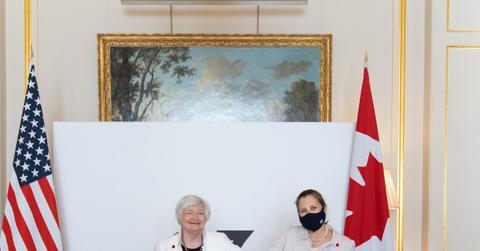U.S. Debt Ceiling, Explained—What Happens If the U.S. Defaults
The situation in the U.S. is fluid as politicians discuss raising the debt ceiling. What happens if the U.S. defaults?
Oct. 12 2021, Published 10:31 a.m. ET

Currently, the U.S. is involved in a debt ceiling debate. The U.S. hit its debt limit on August 1, 2021. Since then, there has been constant bickering about raising the debt ceiling. Republicans are resisting Democrats’ move to raise the debt ceiling. The Department of the Treasury will run out of money soon. According to Treasury Secretary Janet Yellen, it could run out as soon as Oct. 18. What happens to the U.S. dollar if the debt ceiling doesn't get raised and the U.S. defaults?
On Oct. 7, the Senate extended the debt ceiling deadline until December, which means that the default is averted at least until then. Many economists and market experts have been warning that a default could be catastrophic.
What is the debt ceiling?
The debt ceiling is a limit on the Department of the Treasury’s ability to borrow money to pay its debts. The debt ceiling was first imposed by Congress through the Second Liberty Bond Act of 1917, which established a limit of $11.5 billion and required congressional approval for any further increase. Congress has voted nearly 100 times in the past to either raise or suspend the debt limit. Currently, the U.S. debt sits at $28.4 trillion.

The U.S. could default if Congress doesn’t suspend or raise the debt ceiling. So far, the U.S. has never defaulted on its debt. During 2011, a similar situation was witnessed when bickering about raising the debt ceiling led to an unprecedented downgrade of the U.S. credit rating of AAA. The downgrade had far-reaching consequences for the stock markets and the sell-off is now known as Black Monday.
What happens if the U.S. defaults?
If there's a default, the government won’t be able to borrow additional funds to meet its obligations. The consequences of a U.S. default could be catastrophic on many levels.
In the U.S., people getting payments through federal spending, paychecks to civilian and military employees, state and local government grants, and pension funds would all be impacted. For example, social security would see delays for around 65 million beneficiaries. A drop in the U.S. dollar's value would have a ripple effect for the U.S. and world economies.
U.S. default and implications for the U.S. dollar
The default would also cause huge damage to the U.S. dollar since it might lose its unique place as the world’s reserve currency. The U.S. and Americans have been enjoying huge benefits due to the U.S. dollar’s place as a reserve currency. A weakness in USD could mean more expensive imports, which would also impact Americans’ standard of living. A default could also lead to a spike in interest rates, which could ruin the country's creditworthiness.
Apart from default, the political brinksmanship on the debt ceiling could have a negative impact on the GDP. According to Moody’s estimates, similar situations in 2011 and 2013 cost the U.S. 1 percent in GDP growth and 1.2 million jobs.
The debt ceiling has changed over 100 times since its inception. But this time, due to Republicans’ hard resistance, the situation doesn’t seem that clear cut. However, it's possible that President Biden will increase the debt ceiling once more. He will likely need to compromise on spending and tax proposals in order to receive Republican approval.
